Explaining Twitter - One of Three Places for People

Last week a friend who just signed up on Twitter said: "... just like Jon Stewart, I can't figure out how it works or why anyone would want to tweet or get anyone else's twitter. I had no idea what grunt and stalker is but I am assuming that is reality too. I put this all in the pocket with second life (stupid bulky awkward and totally useless)." So I reluctantly joined the crowd attempting to explain why people who have a job and have a life might be interested in Twitter. I decided to describe Twitter as one of three distinct places on the Web where I socialize every day: the public commons. The others two are my neighborhood and my workplace.
Explaining Knowledge Management
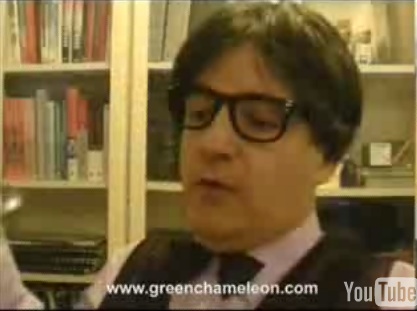
Green Chameleon posts two wonderfully funny fake interviews: Explaining KM #1 (which roasts KM academicians) and Explaining KM #2 (which roasts KM consultants). I hope they go on to produce Explaining KM #3 to roast KM software vendors! Produced by (and starring?) folk from StraitsKnowledge.com, which appears to be a very good Singapore-based consulting and research firm focused on knowledge, learning and innovation.
Enterprise 2.0: Radical Change by Revolution or Mandate?

Ross Dawson's Enterprise 2.0 will bring radical change in organisations quotes Steve Hodgkinson, Ovum research director from an article by Merri Mack writing in Voice and Data magazine:
Enterprise 2.0 Schism
 I have to confess that I've enjoyed watching recent rounds of Enterprise 2.0 discussion and mud wrestling. The fact that so many people enjoy debating definitions, values, doctrinal principals - even the existence of Enterprise 2.0 - makes me think that E2.0 might best be framed as a religious debate. With that in mind, I'd like to introduce a new and exciting element: schism.
I have to confess that I've enjoyed watching recent rounds of Enterprise 2.0 discussion and mud wrestling. The fact that so many people enjoy debating definitions, values, doctrinal principals - even the existence of Enterprise 2.0 - makes me think that E2.0 might best be framed as a religious debate. With that in mind, I'd like to introduce a new and exciting element: schism.
Enterprise 2.0 and the importance of Silo Smashing!

Recent posts by Michael Sampson, John Tropea and Thomas Vander Wal converge on the need for Enterprise 2.0 tools to smash the silos segregating content types and isolating workspaces.
Enterprise 2.0 and Observable Work

I really like Jim McGee's Jun 23, 2010 blog post Managing the visibility of knowledge work. Jim makes the excellent point that "Invisibility is an accidental and little-recognized characteristic of digital knowledge work." and points back to his 2002 post Knowledge Work as Craft Work to reflect on what Jim calls a "dangerous tension between industrial frameworks and knowledge work as craft work". Early in his 2002 post McGee says:
Enterprise 2.0 - Letting hypertext out of its box
 In his Mar 26, 2006 post, Putting Enterprise 2.0 in Perspective, Mike Gotta agrees with Tom Davenport and Andrew McAfee that a balanced discussion of E2.0 should include "... how well an enterprise addresses the complex organizational dynamics that often inhibit change," not just "irrational exuberance regarding the technology."
In his Mar 26, 2006 post, Putting Enterprise 2.0 in Perspective, Mike Gotta agrees with Tom Davenport and Andrew McAfee that a balanced discussion of E2.0 should include "... how well an enterprise addresses the complex organizational dynamics that often inhibit change," not just "irrational exuberance regarding the technology."
Enterprise 2.0 - Are we there yet?
 Andrew McAfee writes Nov 20, 2014: "Facebook’s recent announcement that it’s readying a version of its social software for workplaces got me thinking about Enterprise 2.0, a topic I used to think a great deal about. Five years ago I published a book with that title, arguing that enterprise social software platforms would be valuable tools for businesses...
Andrew McAfee writes Nov 20, 2014: "Facebook’s recent announcement that it’s readying a version of its social software for workplaces got me thinking about Enterprise 2.0, a topic I used to think a great deal about. Five years ago I published a book with that title, arguing that enterprise social software platforms would be valuable tools for businesses...
Why did it take so long? I can think of a few reasons. It’s hard to get the tools right — useful and simple software is viciously hard to make. Old habits die hard, and old managers die (or at least leave the workforce) slowly. The influx of ever-more Millennials has almost certainly helped, since they consider email antediluvian and traditional collaboration software a bad joke.
Whatever the causes, I’m happy to see evidence that appropriate digital technologies are finally appearing to help with the less structured, less formal work of the enterprise. It’s about time.
What do you think? Is Enterprise 2.0 finally here? If so, why now? Leave a comment, please, and let us know."
Emergineering!
 Since introducing the idea of Social Process Reengineering? earlier this week I've socialized it virtually and personally (at E2.0 Boston) with at least a dozen customers, bloggers, analysts and other leading thinkers.
Since introducing the idea of Social Process Reengineering? earlier this week I've socialized it virtually and personally (at E2.0 Boston) with at least a dozen customers, bloggers, analysts and other leading thinkers.
Consensus on the concept was generally positive with a variety of feedback ranging from the matter that the "facebook" approach doesn't just work in the enterprise to the matter that the social, structural and business pain have to be taken into account for successful E2.0 efforts.
Email isn't dead - It's only sleeping

Caroline McCarthy has a wonderful post The future of Web apps will see the death of e-mail. She quotes Kevin Marks:
Eat your spinach: Email is good for you, but it could taste a lot better
Takashi Okutsu of Traction Software's Japanese Business Office says that email is like spinach. It may be necessary for a healthy business, but not everyone likes spinach. He says that it's not reasonable to think that Social Network Software replaces email. It's better to look at how SNS extends and complements email. Takashi's July 3, 2015 TractionSoftware.jp blog post explains how, see this rough Google English translation.
E-Mail: an On-Ramp for Enterprise Social Media
Bill Ives, @billives, points to Nathan Eddy's eWeek column titled Businesses Still Reliant on Email as Social Media Use Grows. The column reminds us that Email is still the dominant go-to application of choice and that's not changing any time soon. Rather than run away from email habits, social software in the enterprise has to embrace it. Back in 2004, I gave a presentation at the INBOX conference advocating for the use of Email as an on-ramp for collaboration and an off-ramp for notification.
Doug Engelbart's copy of As We May Think - with Doug's 1962 notes scribbled in the margins
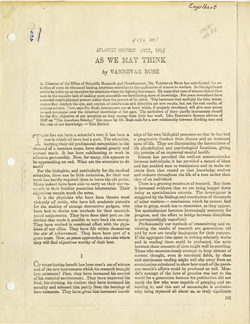
The Doug Engelbart Foundation's 1995 Vannevar Bush Symposium video archive page includes a section on Bush's influence on Doug's work, including his copy of Bush's As We May Think with Doug's 1962 notes in the margins (pdf). Talk about deeply intertwingled living history. Per a note in the .pdf, the original hardcopy has apparently been donated to the Computer History Museum. Look for this paper when the Computer History Museum's Revolution - The First 2000 Years of Computing exhibit opens in Mountain View CA - and online on 13 Jan 2011.
Doug Engelbart | 85th Birthday Jan 30, 2010
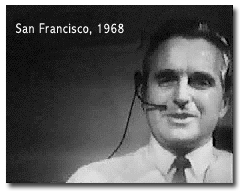 "DOUG Engelbart sat under a twenty-two-foot-high video screen, "dealing lightning with both hands." At least that's the way it seemed to Chuck Thacker, a young Xerox PARC computer designer who was later shown a video of the demonstration that changed the course of the computer world." from What the Dormouse Said, John Markoff.
"DOUG Engelbart sat under a twenty-two-foot-high video screen, "dealing lightning with both hands." At least that's the way it seemed to Chuck Thacker, a young Xerox PARC computer designer who was later shown a video of the demonstration that changed the course of the computer world." from What the Dormouse Said, John Markoff.
Doug Engelbart - Hyperscope Project
See the Hyperscope Project for Doug's newest project (supported by a November 2005 NSF Grant) to apply bootstrapping principles to the evolution of a new generation of tools.
Don't take my word for it - Byrne and Koplowitz on SharePoint
At the Enterprise 2.0conference two weeks ago, Tony Byrne (President, the Real Story Group) and Rob Koplowitz (VP and Principal Analyst, Forrester Research) were joined for the SharePoint Analyst Panel. David Carr's Information Week column Does SharePoint Have Future As A Social Platform frames the debate as lopsided with a simple conclusion: No.
Do Something Differently - Spend less for better results

JP Rangaswami offers typically sound advice for businesses looking at how to cope with hard times in his October 19th post Invented Here. He says when times are hard, a firm has four choices:
Detailed Data Aside, Executives Back E2.0
A new market report, this time by McKinsey& Company, says a majority of executives say they plan to increase investments in technologies which fall under the collective hood of Enterprise and Web 2.0.
Deloitte and Sampson: Focus on process, the "why" not the "what", for social software
I found a common thread on process centric adoption in the Deloitte Center for the Edge's Social Software for Business Performance report and Michael Sampson's User Adoption Strategies book. This advice is reflected in my post on Emergineering from last fall.
December 2010 | Gilbane Conference - Portal vs. Enterprise Social Software Panel
Jordan Frank writes: At the Gilbane Conference last month I stood in for Greg Lloyd in the Portal or Enterprise Social Software: Which Collaboration Environment to Choose? panel with David Seuss (CEO, Northern Light) and Jay Batson (Co-Founder and VP, Acquia).
Daily Report 日報 = Observable Work: Takashi Okutsu
 Takashi Okutsu of Traction Software's Japanese Business Office recently posted an update to his Daily Report TeamPage plugin. Takashi writes: "In some Japanese companies, it is common to look back what an employee did in the day, write a summary, and submit it to his/her boss. This is called "日報" (daily report or daily journal) and it's a way of sharing information between employees and bosses in the hierarchy. If you are interested in the ways of business in Japanese companies, you may find this blog post interesting." This example of Observable Work is very simple to understand and use. Quality Management and other TeamPage solutions follow the same pattern.
Takashi Okutsu of Traction Software's Japanese Business Office recently posted an update to his Daily Report TeamPage plugin. Takashi writes: "In some Japanese companies, it is common to look back what an employee did in the day, write a summary, and submit it to his/her boss. This is called "日報" (daily report or daily journal) and it's a way of sharing information between employees and bosses in the hierarchy. If you are interested in the ways of business in Japanese companies, you may find this blog post interesting." This example of Observable Work is very simple to understand and use. Quality Management and other TeamPage solutions follow the same pattern.
Creating GWT Date / Time Pickers That Work in Any Time Zone
We're working on new features for the next release of TeamPage that allow people to create events on a calendar. For the edit event dialog, we needed date and time pickers that allow people across different time zones to edit the dates and times of events. We ended up creating new GWT controls and adding them to our open source gwt-traction library .
Could I interest you in a Memex?
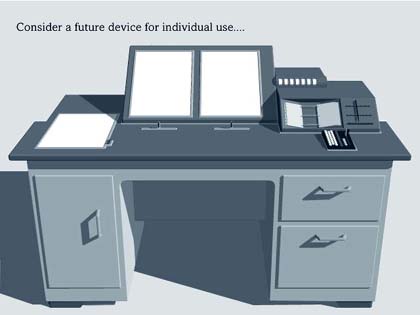
Today Weblogged News (Will Richardson) has a thoughtful post "Proficiency in Tossing Stuff Out", reflecting on Thomas Washington's essay in the Christian Science Monitor. Washington says: "The pursuit of knowledge in the age of information overload is less about a process of acquisition than about proficiency in tossing stuff out."
Continuity and Intertwingled Work
 At Apple's WWDC 2014 on 2 Jun 2014, Apple demonstrated how to build a great user experience spanning a your iPhone, iPad, and Mac. Apple calls this OS level capability Continuity. It enables you to continue what you're doing across devices and applications by securely encapsulating your identity and the context of your action as an object. From picking up a draft email message started on an iPhone and continuing work with that draft on your Mac, to answering an incoming iPhone call on your Mac, I believe this opens the door for a level of seamless experience that everyone will want for personal use, their family, and at work.
At Apple's WWDC 2014 on 2 Jun 2014, Apple demonstrated how to build a great user experience spanning a your iPhone, iPad, and Mac. Apple calls this OS level capability Continuity. It enables you to continue what you're doing across devices and applications by securely encapsulating your identity and the context of your action as an object. From picking up a draft email message started on an iPhone and continuing work with that draft on your Mac, to answering an incoming iPhone call on your Mac, I believe this opens the door for a level of seamless experience that everyone will want for personal use, their family, and at work.
Contextual Computing At Work
 In Co.Design May 24, 2013 Peter Morrison of Jump Associates writes The Future of Technology isn't Mobile, it's Contextual. He says that the way we respond to the world around is based on situational awareness. "The way we respond to the world around us is so seamless that it’s almost unconscious. Our senses pull in a multitude of information, contrast it to past experience and personality traits, and present us with a set of options for how to act or react. Then, it selects and acts upon the preferred path. This process--our fundamental ability to interpret and act on the situations in which we find ourselves--has barely evolved since we were sublingual primates living on the Veldt.
In Co.Design May 24, 2013 Peter Morrison of Jump Associates writes The Future of Technology isn't Mobile, it's Contextual. He says that the way we respond to the world around is based on situational awareness. "The way we respond to the world around us is so seamless that it’s almost unconscious. Our senses pull in a multitude of information, contrast it to past experience and personality traits, and present us with a set of options for how to act or react. Then, it selects and acts upon the preferred path. This process--our fundamental ability to interpret and act on the situations in which we find ourselves--has barely evolved since we were sublingual primates living on the Veldt.
Connections

To the best of my knowledge, Clay Shirky is responsible for popularizing the term Social Software. By his definition, it's primarily about patterns of connections:
Compliance and Enterprise 2.0 - For the right reasons
 Burton Group analyst Mike Gotta writes Compliance Doesn't Sell E2.0 … But It Should in his personal Collaborative Thinking blog. Mike summarizes a June 2009 E2.0 conference interview with Alexander Howard, quoted in Compliance concerns dog Enterprise 2.0 collaboration platforms. Howard asks:
Burton Group analyst Mike Gotta writes Compliance Doesn't Sell E2.0 … But It Should in his personal Collaborative Thinking blog. Mike summarizes a June 2009 E2.0 conference interview with Alexander Howard, quoted in Compliance concerns dog Enterprise 2.0 collaboration platforms. Howard asks:
Collaborative Intelligence in Large or Growing Organizations
Arik Johnson (of AuroraWDC) and I developed a workshop on Collaborative Early Warning. We cover a range of topics from "the Wisdom of Crowds" to how to apply Jan Herring's Key Information Topic protocols to the early warning process. We then break into a teams to review a business case and conduct a war gaming exercise.
Collaboration Tools - Are Information Silos a Problem?
James Robertson's article Collaboration Tools are Anti Knowledge Sharing? discusses the pros and cons of collaboration tools, with particular emphasis on the problems associated with proliferation of 100's or even 1,000's of information silos. Michael Sampson's response nicely vouches for the pros, while cautioning against having a hodgepodge of disparate collaboration tools.
Collaboration - Yesterday, Today & Tomorrow - Boston KM Forum
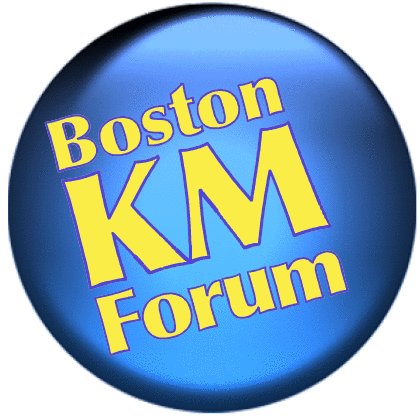 At the Boston KM Forum meeting today, Lynda Moulton and Larry Chait put together a speaker lineup that reminds us of past experience where collaboration worked, and highlights key trends that speak to trends making collaboration a credible activity in the future. I did my best here to capture a few best practices and key learnings.
At the Boston KM Forum meeting today, Lynda Moulton and Larry Chait put together a speaker lineup that reminds us of past experience where collaboration worked, and highlights key trends that speak to trends making collaboration a credible activity in the future. I did my best here to capture a few best practices and key learnings.
Collaborating around the Collaborative Technologies Conference
Greg and I joined panels at CTC which brought together a really great set of speakers from John Seely Brown to Rod Boothby of Ernst & Young and Larry Cannell of Ford Motor. My take away from the conference? Collaboration isn't about documents anymore (and never was).
Collaborating Across "Boundaries" - Searching People for Answers
Mike Gotta points to new research published in HBS Working Knowledge analyzing which groups in an organization are most likely to communicate, crossing social and physical boundaries. The study, Communication (and Coordination?) in a Modern, Complex Organization, reports that "women, mid- to high-level executives and members of executive management, sales and marketing functions are most likely to participate in cross-group communications." It is these people who bridge groups in social structure.
Clash of the Titans 2020 - Peter O'Kelly
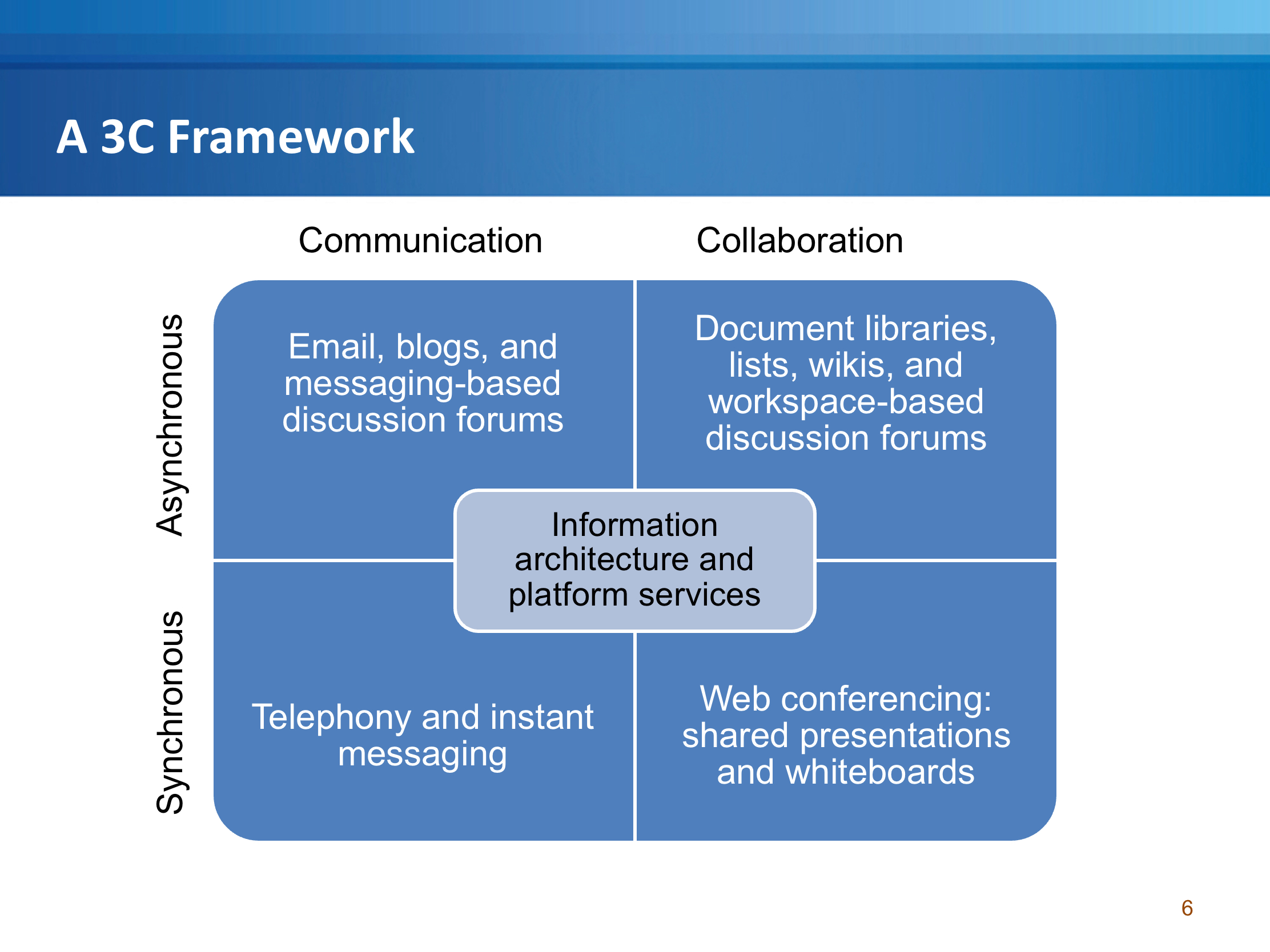 Revisiting Communication/Collaboration/Content Competition, ‘Co-opetition,’ and Culture: Opportunities for Traction Software and its Customer Community, my 2010 Traction User Group (TUG) presentation, it’s fascinating to realize how deeply the product strategies of the leading enterprise communication, collaboration, and content (3C) vendors were disrupted over the last decade. It’s also frankly a bit discouraging to realize how much 3C potential has yet to be realized by most mainstream enterprise end users, although that’s somewhat offset by the knowledge that Traction customers have been benefitting from the ongoing refinement of TeamPage’s pioneering collaborative hypertext journaling system the entire time. In this post, I’ll share perspectives on what has changed in the 3C product families of the vendors identified as enterprise 3C titans in the 2010 presentation along with some highlights of vendors that weren’t part of the 2010 discussion but are important 3C competitors today. I’ll close with some thoughts about where Traction fits into the current enterprise 3C landscape.
Revisiting Communication/Collaboration/Content Competition, ‘Co-opetition,’ and Culture: Opportunities for Traction Software and its Customer Community, my 2010 Traction User Group (TUG) presentation, it’s fascinating to realize how deeply the product strategies of the leading enterprise communication, collaboration, and content (3C) vendors were disrupted over the last decade. It’s also frankly a bit discouraging to realize how much 3C potential has yet to be realized by most mainstream enterprise end users, although that’s somewhat offset by the knowledge that Traction customers have been benefitting from the ongoing refinement of TeamPage’s pioneering collaborative hypertext journaling system the entire time. In this post, I’ll share perspectives on what has changed in the 3C product families of the vendors identified as enterprise 3C titans in the 2010 presentation along with some highlights of vendors that weren’t part of the 2010 discussion but are important 3C competitors today. I’ll close with some thoughts about where Traction fits into the current enterprise 3C landscape.
Clash of the Titans - Peter O'Kelly at TUG 2010
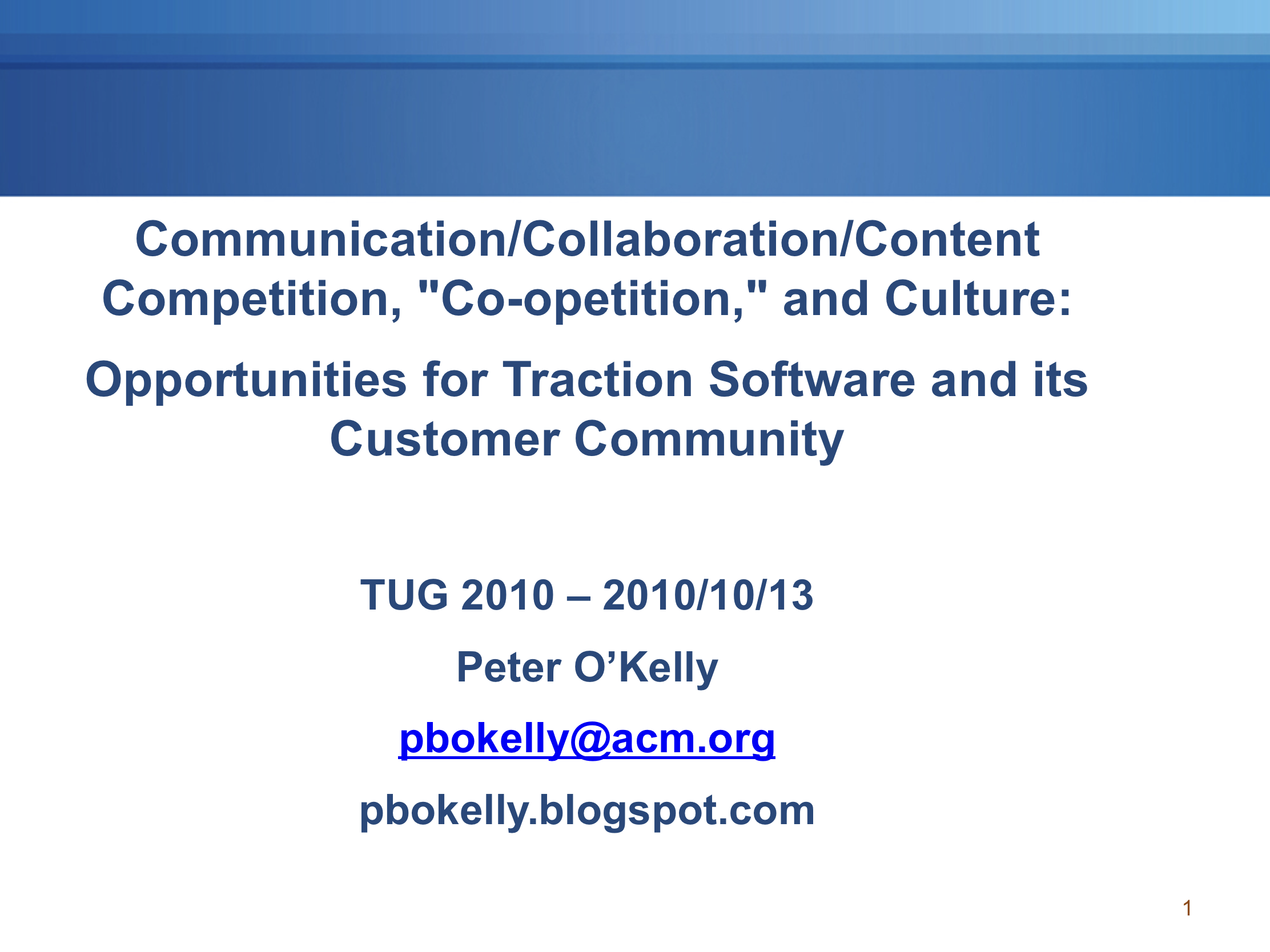 I'm happy to present a transcript and quotes from Peter O'Kelly's TUG 2010 talk Communication / Collaboration / Content Competition, "Co-opetition," and Culture: Opportunities for Traction Software and its Customer Community. Or, as I'll call it here Clash of the Titans. Peter draws on his career as Lotus Notes product manager at Lotus Development Corporation and IBM, IBM Director of Business Development, Groove Networks product manager, MacroMedia vice president of strategy, Microsoft Solutions Architect, and senior analyst or director with the Patricia Seybold Group, the Burton Group, and O'Kelly Associates - see Peter's LinkedIn page and personal blog. I asked Peter to write a 'Where are they now' follow up post, and he cheerfully agreed! Look for it here next week.
I'm happy to present a transcript and quotes from Peter O'Kelly's TUG 2010 talk Communication / Collaboration / Content Competition, "Co-opetition," and Culture: Opportunities for Traction Software and its Customer Community. Or, as I'll call it here Clash of the Titans. Peter draws on his career as Lotus Notes product manager at Lotus Development Corporation and IBM, IBM Director of Business Development, Groove Networks product manager, MacroMedia vice president of strategy, Microsoft Solutions Architect, and senior analyst or director with the Patricia Seybold Group, the Burton Group, and O'Kelly Associates - see Peter's LinkedIn page and personal blog. I asked Peter to write a 'Where are they now' follow up post, and he cheerfully agreed! Look for it here next week.
Clarity Amid the Hype
 Mike Gotta posted Enterprise Twitter: Clarity Amid The Hype analyzing - and generally agreeing with - points raised by Adina Levin (Socialtext) in her excellent post What's Different about Enterprise Twitter? I agree with Mike's analysis and Adina's thoughtful points (read them both) but want to focus on Mike's conclusion:
Mike Gotta posted Enterprise Twitter: Clarity Amid The Hype analyzing - and generally agreeing with - points raised by Adina Levin (Socialtext) in her excellent post What's Different about Enterprise Twitter? I agree with Mike's analysis and Adina's thoughtful points (read them both) but want to focus on Mike's conclusion:
CI Ethics Survey
If you want to benchmark your opinion on Competitive Intelligence practices vs. other respondents, this survey being run by Fuld & Company provides an opportunity. The questions in the survey are also thought provoking and great grist for internal discussion groups.
Chris Nuzum Hyperkult XXV Video | Tripping Up Memory Lane
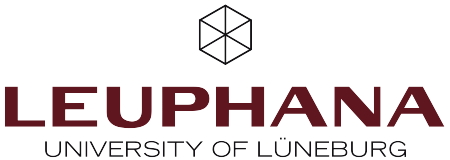 Watch this video of Chris Nuzum's Tripping Up Memory Lane talk at Hyperkult 2015, University of Lüneburg, 10 July 2015. Traction Software CTO and co-founder Chris Nuzum reviews hypertext history, his experience as a hypertext practitioner, and the core principles of Traction TeamPage.
Watch this video of Chris Nuzum's Tripping Up Memory Lane talk at Hyperkult 2015, University of Lüneburg, 10 July 2015. Traction Software CTO and co-founder Chris Nuzum reviews hypertext history, his experience as a hypertext practitioner, and the core principles of Traction TeamPage.
Carving a Path to Productive Knowledge Management: How?
I gave the following presentation at the first ever meeting of the Boston Chapter of the Knowledge Management Association today. As this was a first meeting, I thought I'd raise the issue that "managing knowledge" is about as daunting a task as "herding cats."
Can't stuff the Web back in a box ...

On April 16 2009 Oliver Marks wrote The CIA's Collaboration Growth Curve & IBM's Lotusphere ecosystem connecting three topics: 1) the transformation of the CIA's collaborative practices; 2) how this relates to the concept of the collaboration curve introduced by John Hagel III, John Seely Brown (JSB), and Lang Davison, and 3) his reaction to IBM's Lotusphere Comes to You roadshow event in San Francisco that day. It's a great post which motivated me to add a comment which I expanded a bit below.
Burned by a Bad Choice
Sometimes "free" is hardly that, and TCO calculations don't begin to account for the "cost" of a failed initiative. Below is an anonymized e-mail sent from a manager in one division of a very large global enterprise to another manager in a separate division which is now evaluating Enterprise Wiki software.
Building pleasant and stable islands in a storm-tossed sea

Traction Roots: A Whirlwind Tour (.ppt 6.2MB) tells the Traction story in pictures: 1) Tim Berners-Lee's web trades stable links for utmost simplicity and bottom-up scalability without central control; 2) Traction creates spaces which are pleasant and stable islands with a rich hypertext model internally: bi-direction links; comments based on ternary relations rather than hacking the representation of the referent object; faceted permission models uniformly enforced for search results, cross-references, as well as content browsing; fully journaled actions, etc. 3) Traction generates HTTP addressable views of its content to enable any item in the Traction corpus to be read and linked like the rest of the web (optionally restricted by access controls). This creates a pleasant and stable island that's easily connected to other islands of stability on the Web - as well as anything in the storm tossed sea - not a stovepiped box.
Borders, Spaces, and Places

One big problem for collaboration has been too many borders - technical or cultural - creating silos of information for no good reason - and many bad ones. There's also a big problem if you don't have a good way to mark borders that enable collaboration where there's a natural expectation of privacy.
Blogging Policy = Blabbing Policy
I have been asked by many current and prospective customers these days about best practices for internal and external blogging policy.
Big Data, Meet Long Data, Meet Blog Data
Big Data Meet Long Data by Jeff Bertolucci - @jbertolucci - column appears this week in InformationWeek to reminds us that "Long Data" or historical data is vital for analysis and comprehension of trends that span years.
Beyond blogs and wikis
I really like David Berlind's post IBM's Suitor asks how you share documents. Wrong question, right time (May 2, 2006). David makes a great points including: "Think about freeing your knowledge. Then worry about the format (after your thinking leads you to regular document land)." But I think David edges close to a similar problem in characterizing blogs vs. wiki's - particularly with respect to Traction and other products which purposefully blur the boundaries.
Beta Bloggers Need Not Lurk in the Enterprise
KnowledgeJolt with Jack writes about a study reported on Jakob Nielson's AlertBox about Participation Inequality: Lurkers vs. Contributors in Internet Communities. Jack agrees and expands on Jakob's recommendations for increasing participation. Both are on point for public internet communities like wikipedia, group blogs and product review sites. However, the problem can be simplified in enterprise settings when catering to beta bloggers.
|
Best Practice and the Wikipedia Big Brain
At the recent Interop New York (see TechWeb story), Andrew McAfee compares Wikipedia to an ant colony, suggesting that the opposite of imposed structure is not chaos. He said:
Best Practice and the Wiki Big Brain - An MBA Class Case Study
Some of my past entries (Best Practice and the Wikipedia Big Brain, Yin and Yang of E2.0, and Pros and Cons of Emergence) have discussed the importance of some structure in the collaboration process, even when using software like wikis and blogs which can permit N degrees of emergent structure. A recent sustained effort by an MBA class in Israel illustrates the importance and benefit of applying structure to the task.
Avast Ye Enterprise 2.0 Seekers!
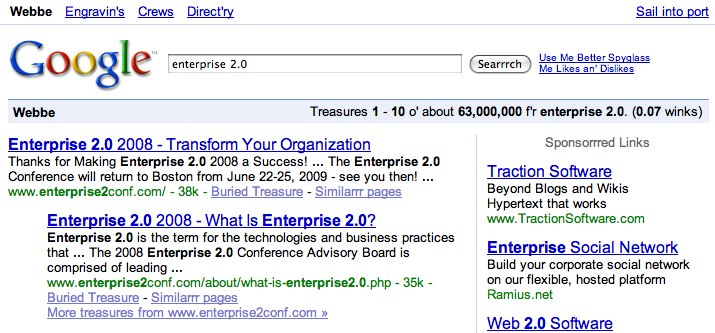
If ye be seeking Enterprise 2.0 Skills, click Traction Software or prepare to be Boarded, Pillaged and Sunk by thy Competition! If thou knowes't not how Enterprise 2.0 Skills canst Protect thy Treasure - Unto thy very Corporate Life - Profesaarh Andrew McAfee can set thee aright. Arrhh!
Automatic vs. Manual Tagging - Born to tag? and to What End?
Dennis McDonald recently posted an entry on his experience with Reuters' automatic tagging tool called Calais. He concludes:
Authority versus Page Rank
On 15 Sep 2006 Tim Bray wrote in Wikipedia: Resistance is Absent:
At What Scale Can Web Services Survive?
One more data point in line of my Whither Web 2.0 Social Networking Discussion which questions the revenue models of web services (with web social networking as a focal point): An on-line service the scale and scope of Microsoft's Online Services is running into red ink of proportional scale. It lost $471 Million per last quarter. The clear and present issue is not whether a profit may be turned at some even-large scale, but what will change about the business model and how will that affect users?
Ask an Engineer: What do you think of the Facebook Terms of Service Flap?

If you haven't been paying attention to this week's flap on Facebook's revised terms of service - posted three days ago and retracted today - Andrew Lavelle of the Wall Street Journal published a good recap today. The controversy relates to what rights does Facebook get to content that an individual Facebook user posts? There are a lot of good arguments about what rights people think Facebook should be able to retain, but there's a second level of discussion that relates to how people expect Facebook privacy settings to work, and how these expectations make it difficult to craft an agreement that seems fair, makes sense, and corresponds to what Facebook actually implements and enforces.
As We May Work - Andy van Dam
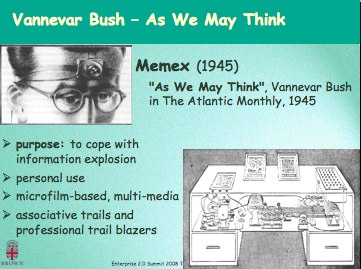
On April 17, 2008 Professor Andy van Dam of Brown University delivered the keynote address of the Enterprise 2.0 Summit 2009 Tokyo. Andy's title is a play on Vannevar Bush's July 1945 essay As We May Think. As We May Think inspired creation of pioneering hypertext systems by Andy, Ted Nelson, Doug Engelbart and others, leading to Tim Berners-Lee and the World Wide Web. The creators of these hypertext systems originally envisioned an environment where individuals could write, link, comment on and share what they wrote as well as search and read what others had written - core capabilities of what we now call social software for the public Web or an Enterprise. Andy's keynote is a personal history, and a vision of how the Web provides a new context for work as well as public communication, socialization, commerce, scholarship and entertainment. For the full slide set see As We May Work (.ppt 8.8MB), posted here with Andy's permission.
Ariadne | Information Overload Paper - 10 ways to cope
Sarah Houghton-Jan wrote and excellent paper, Being Wired or Being Tired: 10 Ways to Cope with Information Overload, in Ariadne (a Web Magazine for Information Professionals). It's actually ten general areas for coping, each with about 5 suggestions. Ever since Kid 1 and Kid 2 popped into my life, dealing with every kind of overload (e-mail overload, magazine overload, chores overload, poop overload...) has become a factor in my life!
April 2006 | Red Herring Short Lists Traction Again
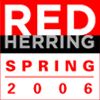
Red Herring short listed Traction® Software as one of 200 of the most innovative technology firms in North America. Criteria include financial performance, technology innovation, execution on strategy, management quality, and integration into their ecosystem. This assessment allows Red Herring to see past the “buzz” and make the
list an invaluable instrument for discovering and advocating the
greatest business opportunities in the industry. Red Herring's Spring 2006 event is themed The Pursuit of Disruption. Traction was selected to the Red Herring 100 for 2004 and we're pleased to be recognized as a leader this year by Red Herring and others including eContent and KM World. » Read Red Herring's Full Release. » link 'Read Traction Software's Full Release' public641
Applied Knowledge Co Ltd - Bringing Traction TeamPage 5.1 to Japan
 Our long-time Japanese reseller partner Applied Knowledge Co Ltd has done a great job bringing Traction TeamPage to the Japanese market. They are an excellent sales and consulting partner for Japanese market customers. AKJ also has deep experience applying Enterprise 2.0 principles, the Traction TeamPage SDK, Japanese Language localization of the TeamPage interface, and Japanese advanced linguistics and faceted navigation capabilities of Traction's Attivio powered Advanced Search.
Our long-time Japanese reseller partner Applied Knowledge Co Ltd has done a great job bringing Traction TeamPage to the Japanese market. They are an excellent sales and consulting partner for Japanese market customers. AKJ also has deep experience applying Enterprise 2.0 principles, the Traction TeamPage SDK, Japanese Language localization of the TeamPage interface, and Japanese advanced linguistics and faceted navigation capabilities of Traction's Attivio powered Advanced Search.
Apocalypse?
Regarding Yahoo's new The 9, Tim Bray writes: "This is the End, maybe, of Civilization As We Know It. I’m thinking now would be a good time for the Borg to come along and assimilate us all..." Come on Tim! Hardly the Apocalypse! Somewhere between the burning of the library of Alexandria and the first Entertainment Tonight.
Anti-Social Software
 It's common to read about corporate culture as a big barrier to successful adoption and use of social software in business. It's easy to understand people's reluctance to change and adopt a new way of working. There are many good reasons to be wary of the promised benefits of change if you don't have relevant direct experience ("I've used this and it works"), clear examples, trust in your organization, and trust in your leadership. Books like Jacob Morgan's new The Collaborative Organization offer great practical guidance, examples, and answers to important questions. However, most social business advice makes a common and good-natured assumption that your organization is healthy - or at least has good intentions - but is just hard to convince. That's not always true.
It's common to read about corporate culture as a big barrier to successful adoption and use of social software in business. It's easy to understand people's reluctance to change and adopt a new way of working. There are many good reasons to be wary of the promised benefits of change if you don't have relevant direct experience ("I've used this and it works"), clear examples, trust in your organization, and trust in your leadership. Books like Jacob Morgan's new The Collaborative Organization offer great practical guidance, examples, and answers to important questions. However, most social business advice makes a common and good-natured assumption that your organization is healthy - or at least has good intentions - but is just hard to convince. That's not always true.
Andy Keller talks about Traction's use of GWT | Video
May 12, 2009 5:38pm rotkapchen Great explanation: Traction Director of Engineering Andy Keller tells why Traction's chose GWT (Google Web Toolkit) for TeamPage's new interaction layer. View video inline below or youtube.com/watch…
And here's what Enterprise 2.0 looked like in 1968 | Dealing lightning with both hands...
The video This is what the web looked like in 1994 - a DEC promotional video of that era - got a bit of attention recently. Just for the record - here's what Enterprise 2.0 looked like in 1968 - courtesy Doug Engelbart and his team at SRI:
An Infinite Number of Cats on Keyboards: Ted Nelson & Computer Lib at Homebrew Computer Club Reunion
Order a perfect reprint of the original version of Computer Lib / Dream Machines directly from Ted Nelson, autographed if you wish. Highly recommended.
All in a Day's Work - The Magnitude of Collaboration
Spending just a little time looking at specifics on your own collaboration patterns sheds light on the central role of communication and collaboration in the every day business process of a "knowledge worker."
Ada Lovelace Day | Sunita Williams, Astronaut and Captain U.S. Navy
 Ada Lovelace Day celebrates the contributions of women in science and technology. This year I've chosen to write about Suni Williams, NASA Astronaut and US Navy Captain currently commanding Expedition 33 on the International Space Station. I hope young women reading about Ada Lovelace Day now are encouraged by her example to pursue their dreams where ever they may lead - here on Earth or as the first Earthling to set foot on Mars.
Ada Lovelace Day celebrates the contributions of women in science and technology. This year I've chosen to write about Suni Williams, NASA Astronaut and US Navy Captain currently commanding Expedition 33 on the International Space Station. I hope young women reading about Ada Lovelace Day now are encouraged by her example to pursue their dreams where ever they may lead - here on Earth or as the first Earthling to set foot on Mars.
Ada Lovelace Day | Professor Lee S. Sproull, Stern School, NYU

For this first Ada Lovelace Day I've chosen to write about Professor Lee Sproull an internationally-recognized sociologist whose research centers on the implications of computer-based communication technologies for managers, organizations, communities, and society. Professor Sproull is a pioneer and visionary in the rigorous study of what we now call social software.
Ada Lovelace Day | Marissa Ann Mayer, Software Engineer, Product Manager, and Executive
Ada Lovelace Day celebrates  the contributions of women in science and technology, follow @FindingAda for news and events. This year I've chosen to write about Marissa Ann Mayer Software Engineer, Product Manager, and Executive, currently President and CEO of Yahoo! Over her career Ms Mayer earned exceptional recognition for Computer Science teaching (while working for her Stanford degrees), software engineering, design, product management, and her executive skills. Ms Mayer joined Google as employee number twenty in 2009 and played an instrumental role leading Google Search for over 10 years.
the contributions of women in science and technology, follow @FindingAda for news and events. This year I've chosen to write about Marissa Ann Mayer Software Engineer, Product Manager, and Executive, currently President and CEO of Yahoo! Over her career Ms Mayer earned exceptional recognition for Computer Science teaching (while working for her Stanford degrees), software engineering, design, product management, and her executive skills. Ms Mayer joined Google as employee number twenty in 2009 and played an instrumental role leading Google Search for over 10 years.
Ada Lovelace Day | Fran Allen, IBM Fellow and A.M. Turing Award Winner
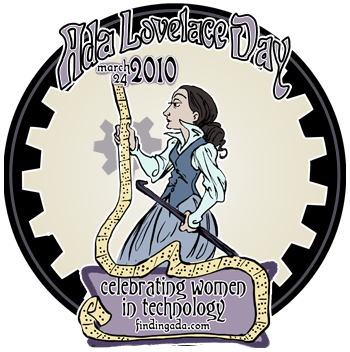 For the second annual Ada Lovelace Day, March 24, 2010 - celebrating women in science and technology - I've chosen to write about Frances E. Allen, IBM Fellow, Turing Award winner and pioneer in the theory and practice of optimizing compilers. I've never had the pleasure of meeting her in person, but I'll take the liberty of calling her Fran, as Dick Merwin and everyone I know called her in their Fran stories.
For the second annual Ada Lovelace Day, March 24, 2010 - celebrating women in science and technology - I've chosen to write about Frances E. Allen, IBM Fellow, Turing Award winner and pioneer in the theory and practice of optimizing compilers. I've never had the pleasure of meeting her in person, but I'll take the liberty of calling her Fran, as Dick Merwin and everyone I know called her in their Fran stories.
Ada Lovelace Day | Emmy Noether, Mathematician
Ada Lovelace Day celebrates  the contributions of women in science and technology, follow @FindingAda for news and events. This year I've chosen to write about mathematician Amalie "Emmy" Noether. At the time of her death in April 1935, she was described by Pavel Alexandrov, Albert Einstein, Herman Weyl, Norbert Weiner and others as the most important woman in the history of mathematics. Noether’s First Theorem is a fundamental tool of modern physics and the calculus of variations: every symmetry corresponds to a conservation law. "It was her work in the theory of invariants which led to formulations for several concepts of Einstein's general theory of relativity." [J J O'Connor and E F Robertson, 1997]. Of her later work, Nathan Jacobson said: "The development of abstract algebra, which is one of the most distinctive innovations of twentieth century mathematics, is largely due to her – in published papers, in lectures, and in personal influence on her contemporaries." Einstein wrote Noether's obituary in the New York Times, May 5, 1935:
the contributions of women in science and technology, follow @FindingAda for news and events. This year I've chosen to write about mathematician Amalie "Emmy" Noether. At the time of her death in April 1935, she was described by Pavel Alexandrov, Albert Einstein, Herman Weyl, Norbert Weiner and others as the most important woman in the history of mathematics. Noether’s First Theorem is a fundamental tool of modern physics and the calculus of variations: every symmetry corresponds to a conservation law. "It was her work in the theory of invariants which led to formulations for several concepts of Einstein's general theory of relativity." [J J O'Connor and E F Robertson, 1997]. Of her later work, Nathan Jacobson said: "The development of abstract algebra, which is one of the most distinctive innovations of twentieth century mathematics, is largely due to her – in published papers, in lectures, and in personal influence on her contemporaries." Einstein wrote Noether's obituary in the New York Times, May 5, 1935:
Ada Lovelace Day | Betts Wald, US Naval Research Lab
 Ada Lovelace Day celebrates the contributions of women in science and technology. I've chosen to write about Betts Wald who was a branch chief in the Communications Science division of the US Naval Research Laboratory (NRL) when I first met her. I joined NRL in 1974 as my first real job - after serving in the US Army when I was drafted as a graduate student at Brown. It was a great experience. NRL was full of wildly talented, energetic and brilliant managers who knew how to get impossible things done in engineering and government, and taught that skill to their teams. Betts was one of the best: leading and inspiring her team, running interference, providing just enough technical guidance (i.e. to avoid permanent damage) while constantly encouraging and developing her team's talents. Women in science and technology should be encouraged to consider career paths as leaders as well as individual contributors: Betts is a great role model. Although I never heard Betts shout: "To the difference engine!", except for the pipe it would be in character. And I'm not certain about the pipe.
Ada Lovelace Day celebrates the contributions of women in science and technology. I've chosen to write about Betts Wald who was a branch chief in the Communications Science division of the US Naval Research Laboratory (NRL) when I first met her. I joined NRL in 1974 as my first real job - after serving in the US Army when I was drafted as a graduate student at Brown. It was a great experience. NRL was full of wildly talented, energetic and brilliant managers who knew how to get impossible things done in engineering and government, and taught that skill to their teams. Betts was one of the best: leading and inspiring her team, running interference, providing just enough technical guidance (i.e. to avoid permanent damage) while constantly encouraging and developing her team's talents. Women in science and technology should be encouraged to consider career paths as leaders as well as individual contributors: Betts is a great role model. Although I never heard Betts shout: "To the difference engine!", except for the pipe it would be in character. And I'm not certain about the pipe.
Aberdeen Survey | Getting Social About Selling
Smart enterprises are deploying blogs and wikis to power the Enterprise front line: Sales. Use cases may involve using Enterprise 2.0 technology to distribute timely market information, maintain a continuous loop of customer feedback, or maintain a wiki to manage selling points, FAQs, and collateral.
A Web That Works | NHS Orkney
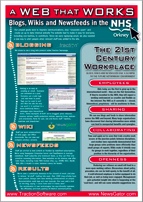
David Rendall, National Health Service Orkney created his A Web That Works blog to complement his poster presentation at the UK's National Health Service conference: Delivering Healthcare in the 21st Century, 11-12 Jun 2007, Glasgow UK. David co-authored a 30 July 2007 Intranet Journal article about his experience with Traction Software's Jordan Frank. Visit David's blog ! To download a full-size copy of David's poster (3.2MB .jpg) click here, posted with David's permission.
A new TeamPage logo, and a new look at Traction Software.com
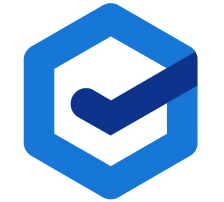 You'll be seeing the new TeamPage logo here, on Twitter, Facebook, across the Web, and next to TeamPage sites shown in your browser's tabs; I hope you like the it! I also hope you like the the new look at TractionSoftware.com. Our customers believe TeamPage is ideal for work that combines collaboration and action tracking, including quality management, human resources, project work, intelligence analysis, knowledge management, and compliance. We want TractionSoftware.com to tell this story simply and clearly, and we'll continue to improve this site just as we continually improve TeamPage. Please contact us for insights into how customers use TeamPage to get work done, along with a free trial.
You'll be seeing the new TeamPage logo here, on Twitter, Facebook, across the Web, and next to TeamPage sites shown in your browser's tabs; I hope you like the it! I also hope you like the the new look at TractionSoftware.com. Our customers believe TeamPage is ideal for work that combines collaboration and action tracking, including quality management, human resources, project work, intelligence analysis, knowledge management, and compliance. We want TractionSoftware.com to tell this story simply and clearly, and we'll continue to improve this site just as we continually improve TeamPage. Please contact us for insights into how customers use TeamPage to get work done, along with a free trial.
A Focus on Individual Users
With Dartmouth President Jim Kim's recent nomination to the World Bank, I pulled out my copy of Mountains beyond Mountains to find the Kim quote that I found most inspiring for my day to day work.
A Fabric, not a Platform
 Apple and Google are competing to build a fabric that connects everything you own and use, working outward from the globally meshed supercomputer you carry in your pocket. Both apply deep learning technology to AI assistants, and are opening up their AIs and bots to other apps, bots, and cloud services. This richly connected fabric makes bots useful and AI assistants valuable by teaching them how to identify objects you're talking about as well as understand what you want done. The same applies at work. Making this happen requires a shift from the traditional definition of a platform to a fabric which makes it possible to connect people and the actionable objects they use, in context.
Apple and Google are competing to build a fabric that connects everything you own and use, working outward from the globally meshed supercomputer you carry in your pocket. Both apply deep learning technology to AI assistants, and are opening up their AIs and bots to other apps, bots, and cloud services. This richly connected fabric makes bots useful and AI assistants valuable by teaching them how to identify objects you're talking about as well as understand what you want done. The same applies at work. Making this happen requires a shift from the traditional definition of a platform to a fabric which makes it possible to connect people and the actionable objects they use, in context.
A Cooperative Strategy for 21st Century Seapower Strategy | Video
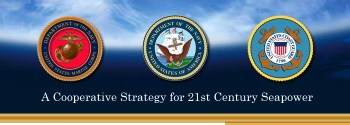
I'm just back from the 2008 Current Strategy Forum at the US Naval War College in Newport. This year the topic of panels and presentations (including addresses and extensive Q&A by the Secretary of the Navy, Chief of Naval Operations and, the Commandant of the Marine Corp) was the Cooperative Strategy for 21s Century Seapower - a joint strategy for the US Marine Corp, Navy and Coast Guard. The strategy raises prevention of war - deterrence, cooperative relationships with more international partners, trust built through humanitarian assistance and disaster response - to an equal level as the conduct of war. In the very best sense this is a positioning statement: what a nation should expect from its maritime forces.
A Circle is not a Space
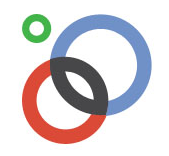 Like many people in the tech industry, I've been happily exploring and enjoying Google+ for the past week or so (thank you Susan Scrupski for the early invitation). I like the Google+ bar, polished integration with Google Profiles, Photos, and Video, as well as the new Huddle and Hangout capabilities. And I'm looking forward to Google+ integrated Search. Nov 20, 2015 update: Google's updated Community and Collection model finally gives Google+ something like a shared Spaces as well as email-like Circles. Keep reading for thoughts on why Circles never caught on. - grl
Like many people in the tech industry, I've been happily exploring and enjoying Google+ for the past week or so (thank you Susan Scrupski for the early invitation). I like the Google+ bar, polished integration with Google Profiles, Photos, and Video, as well as the new Huddle and Hangout capabilities. And I'm looking forward to Google+ integrated Search. Nov 20, 2015 update: Google's updated Community and Collection model finally gives Google+ something like a shared Spaces as well as email-like Circles. Keep reading for thoughts on why Circles never caught on. - grl
31 May 2007 | Traction TeamPage a hit at LinuxWorld Japan
Congratulations to our Japanese partners SEL and AKJ on a great showing for Traction TeamPage at LinuxWorld Japan 2007. SEL was a gold sponsor and launched a Japanese TeamPage customer forum in advance of the event.
29 July 2010 | Enterprise 2.0 and Observable Work: Brian Tullis and Joe Crumpler, Burton Group Catalyst 2010 Santa Diego
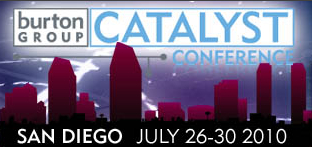
Brian Tullis and Joe Crumpler did a lively talk on Enterprise 2.0 and Observable Work at the Burton Group Catalyst 2010 North America conference in San Diego. For those of us who couldn't be there in person, see their Abstract quoted below and the enthusiastic Twitter stream from 29 Jul 2010! I'll add a link to their speaker notes and slides when they become available. Update: Brian posted Enterprise 2.0 and Observable work slides and speaker notes, see inline Slideshare below. Sounded like a super session!
23 July 2008 | Virtual E2.0 Conference - Traction Sponsors Forrester Keynote
 Register Now (free admission) to join in on the Enterprise 2.0 Virtual Conference on the 23rd of July. The Agenda kicks off at 12:00 with Gartner Analyst David Mitchell Smith's Keynote Innovating the Enterprise with Web 2.0 and ends with a Forrester Analyst Rob Koplowitz's Keynote Control vs. Chaos: The Enterprise Web 2.0 Effect.
Register Now (free admission) to join in on the Enterprise 2.0 Virtual Conference on the 23rd of July. The Agenda kicks off at 12:00 with Gartner Analyst David Mitchell Smith's Keynote Innovating the Enterprise with Web 2.0 and ends with a Forrester Analyst Rob Koplowitz's Keynote Control vs. Chaos: The Enterprise Web 2.0 Effect.
2.0 Adoption Council | Neat Tweet!
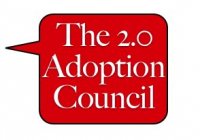
Susan Scrupski (aka @ITSinsider) tweets Sep 22, 2009: reading a great preso by a Council member. great testimony for e20 vendor Traction Software @TractionTeam
11-12 September 2007 | Traction User Group Meeting
 Our second annual Traction User Group (TUG) meeting was held last week in Newport, RI. The two day event featured twenty-six speakers including:
Our second annual Traction User Group (TUG) meeting was held last week in Newport, RI. The two day event featured twenty-six speakers including:
#E2L09 Innovation Starts with Ideas. Wiki will Cross the Work 2.0 Frontier When TeamPage 5.0 Carries Ideas into Action.
These case studies are a taste of how ideas and issues turn into action, how tasks evolve from conversations and how boundaries have to appear to disappear for W2.0 ideas to meet E2.0 execution. See you at E2.0.
"Same old, same old" & Enterprise 2.0 Durability
When asked "How are things?" a college friend used to reply "Same old, same old" as a way of saying "Nothing has changed, nothing's gone wrong, things are fine." This was always good to hear.
"Probably the coolest vendor pricing page I've seen for any collaboration vendor" ~ Jacob Morgan
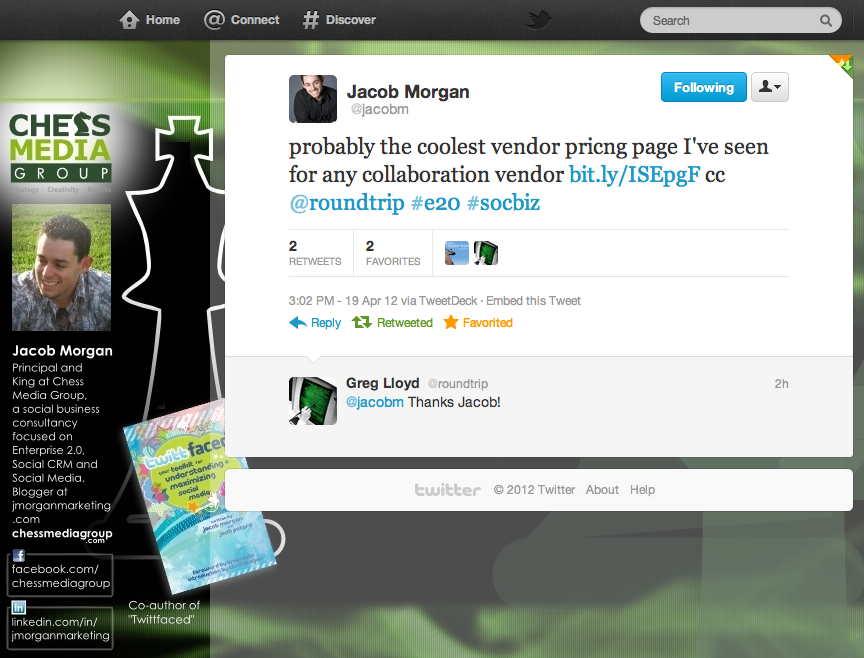
Thanks to Jacob Morgan, Chess Media Group for his Tweet this afternoon while we were chatting on the phone. Last October Jacob reviewed Traction TeamPage in his Emergent Collaboration Vendor series, and liked what he saw, including TeamPage pricing. He said: "I had the pricing explained to me so I understand it but I think it would be helpful if they made it easier to understand for all site visitors because it really does make sense." We agree on both points! In updating the Buy page, Chris Nuzum used Apple Store product configuration pages as benchmarks for clarity and ease of use.
"Control Doesn't Scale" Part II - Let Go to Grow
In yesterday's note Control Doesn't Scale, I talked about how Enterprise 2.0 relies on an Enterprise 2.0 architecture and approach in order to work more like the web. Reflecting on a speech by Andrew McAfee at FASTForward 08, Bill Ives puts the matter very nicely:
"Control Doesn't Scale"
David Weinberger has an incredible knack for putting information management issues into perspective, and always does so with just the right amount of humor and sarcasm (something I generally aim to achieve - but I imagine I fall short of a perfect Weinberger).
"All of this has led me to believe that something is terribly wrong with e-mail. What’s more, I don’t believe it can be fixed."
 "All of this has led me to believe that something is terribly wrong with e-mail. What’s more, I don’t believe it can be fixed," writes New York Times columnist Nick Bilton - not pictured on right - in his July 8, 2012 Bits column, Disruptions: Life's Too Short for So Much Email. He's cranky just because he received 6,000 emails this month, not including spam and daily deals. Nick says: "With all those messages, I have no desire to respond to even a fraction of them. I can just picture my tombstone: Here lies Nick Bilton, who responded to thousands of e-mails a month. May he rest in peace."
"All of this has led me to believe that something is terribly wrong with e-mail. What’s more, I don’t believe it can be fixed," writes New York Times columnist Nick Bilton - not pictured on right - in his July 8, 2012 Bits column, Disruptions: Life's Too Short for So Much Email. He's cranky just because he received 6,000 emails this month, not including spam and daily deals. Nick says: "With all those messages, I have no desire to respond to even a fraction of them. I can just picture my tombstone: Here lies Nick Bilton, who responded to thousands of e-mails a month. May he rest in peace."
 I18N ERROR: @tsiskin#footer_RSS_Feed
I18N ERROR: @tsiskin#footer_RSS_Feed